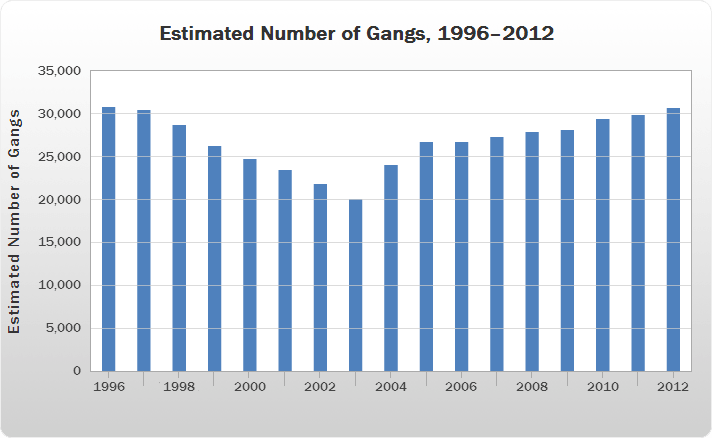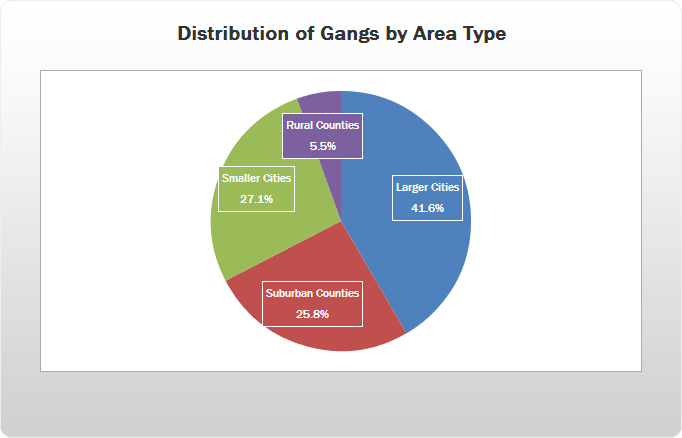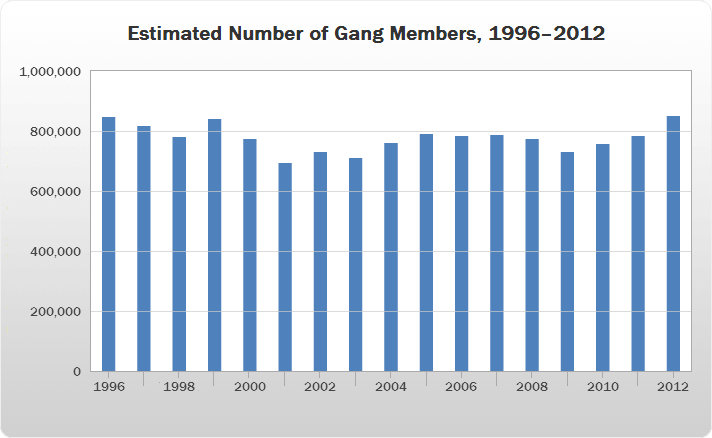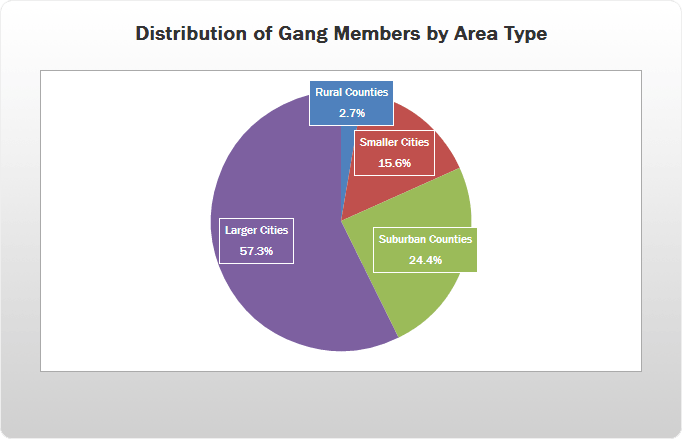Measuring the Extent of Gang Problems
Estimated Number of Gangs
Respondents provided information regarding the number of active gangs in their jurisdictions during each survey year.
- Over the past decade, annual estimates of the number of gangs have averaged around 27,000 nationally.
- Following a yearly decline from 1996 to a low in 2003, annual estimates steadily increased through 2012.
- The most recent estimate of more than 30,000 gangs represents a 15 percent increase from 2006 and is the highest annual estimate since 1996.
| Year | Estimated Number of Gangs |
|---|---|
| 1996 | 30,800 |
| 1997 | 30,500 |
| 1998 | 28,700 |
| 1999 | 26,200 |
| 2000 | 24,700 |
| 2001 | 23,500 |
| 2002 | 21,800 |
| 2003 | 20,100 |
| 2004 | 24,000 |
| 2005 | 26,700 |
| 2006 | 26,700 |
| 2007 | 27,300 |
| 2008 | 27,900 |
| 2009 | 28,100 |
| 2010 | 29,400 |
| 2011 | 29,900 |
| 2012 | 30,700 |
Distribution of Gangs by Area Type
The distribution of gangs by area type is presented.
- Larger cities and suburban counties remain the primary locations of gangs, accounting for roughly two-thirds nationwide.
- Smaller cities account for just 27 percent, and rural counties account for just over 5 percent.
| Percent | |
|---|---|
| Larger Cities | 41.6% |
| Suburban Counties | 25.8% |
| Smaller Cities | 27.1% |
| Rural Counties | 5.5% |
Number of Gangs by Area Type
The annual maximum number of gangs reported since 2006 is displayed by area type.
- While larger cities and suburban counties expectedly report higher numbers of gangs, there is also considerable variation within each area type.
- More than half of suburban counties and 45 percent of larger cities report 10 or fewer active gangs in their jurisdictions.
- A majority of agencies in smaller cities and rural counties report fewer than five gangs.
| Number of Gangs | Larger Cities | Suburban Counties | Smaller Cities | Rural Counties |
|---|---|---|---|---|
| No Data Reported | 2.6% | 8.6% | 6.5% | 12.3% |
| Fewer than 5 | 13.7% | 26.4% | 53.8% | 55.8% |
| 5–10 | 31.5% | 24.8% | 30.2% | 23.9% |
| 11–25 | 25.5% | 21.5% | 8.8% | 8.0% |
| More than 25 | 26.7% | 18.6% | 0.8% | 0.0% |
Analysis for this section pertains only to law enforcement agencies reporting gang problems. Please see the Prevalence of Gang Problems section.
Estimated Number of Gang Members
Respondents provided information regarding the number of active gang members in their jurisdictions during each survey year.
- Over the past decade, annual estimates of the number of gang members have averaged around 770,000 nationally.
- The most recent estimate of approximately 850,000 gang members represents an 8.6 percent increase over the previous year.
| Year | Estimated Number of Gang Members |
|---|---|
| 1996 | 846,500 |
| 1997 | 816,000 |
| 1998 | 780,000 |
| 1999 | 840,500 |
| 2000 | 772,500 |
| 2001 | 693,500 |
| 2002 | 731,500 |
| 2003 | 710,500 |
| 2004 | 760,000 |
| 2005 | 789,500 |
| 2006 | 785,000 |
| 2007 | 788,000 |
| 2008 | 774,000 |
| 2009 | 731,000 |
| 2010 | 756,000 |
| 2011 | 782,500 |
| 2012 | 850,000 |
Distribution of Gang Members by Area Type
The distribution of gang members by area type is presented.
- Larger cities and suburban counties remain the primary locations of gang members, accounting for more than 80 percent nationwide.
- Smaller cities account for approximately 16 percent of gang members, and rural counties account for less than 3 percent.
| Percent | |
|---|---|
| Rural Counties | 2.7% |
| Smaller Cities | 15.6% |
| Suburban Counties | 24.4% |
| Larger Cities | 57.3% |
Number of Gang Members by Area Type
The annual maximum number of gang members reported since 2006 is displayed by area type.
- While larger cities and suburban counties expectedly report higher numbers of gang members, there is also a vast amount of variation within each area type.
- Nearly one in five larger cities reported more than 1,000 gang members, compared with about one in ten suburban counties.
- Approximately one-quarter of the smaller cities and rural counties reported fewer than 25 gang members—the most frequent response among both groups.
- Compared with larger cities, the remaining three area types were significantly more likely to be uncertain of the number of local gang members, indicated by higher proportions of “no data reported.”
| Number of Gang Members | Larger Cities | Suburban Counties | Smaller Cities | Rural Counties |
|---|---|---|---|---|
| No Data Reported | 6.0% | 23.0% | 19.5% | 26.1% |
| Fewer than 25 | 6.7% | 15.8% | 28.2% | 27.5% |
| 25–50 | 7.2% | 11.5% | 26.3% | 23.2% |
| 51–100 | 12.1% | 9.8% | 11.5% | 9.4% |
| 101–250 | 19.5% | 11.1% | 9.5% | 10.1% |
| 251–500 | 16.5% | 11.7% | 4.2% | 3.6% |
| 501–1,000 | 13.0% | 6.8% | 0.8% | 0.0% |
| 1,001–2,500 | 10.4% | 5.7% | 0.0% | 0.0% |
| More than 2,500 | 8.6% | 4.7% | 0.0% | 0.0% |
Analysis for this section pertains only to law enforcement agencies reporting gang problems. Please see the Prevalence of Gang Problems section.
Number of Gang-Related Homicides*
*Because of the many issues surrounding the maintenance and collection of gang-crime data, caution is urged when interpreting the results presented below. For more information regarding this issue, see: https://nationalgangcenter.ojp.gov/about/faq#faq-5-how-are-gang-crimes-especially-gang-related.
The number of gang-related homicides reported from 2007 to 2012 is displayed by area type and population size.
- From 2007 through 2012, a sizeable majority (more than 80 percent) of respondents provided data on gang-related homicides in their jurisdictions.
- The total number of gang homicides reported by respondents in the NYGS sample averaged nearly 2,000 annually from 2007 to 2012. During roughly the same time period (2007 to 2011), the FBI estimated, on average, more than 15,500 homicides across the United States (www.fbi.gov/about-us/cjis/ucr/crime-in-the-u.s/2011/crime-in-the-u.s.-2011/tables/table-1). These estimates suggest that gang-related homicides typically accounted for around 13 percent of all homicides annually.
- Highly populated areas accounted for the vast majority of gang homicides: nearly 67 percent occurred in cities with populations over 100,000, and 17 percent occurred in suburban counties in 2012.
- The number of gang-related homicides decreased 2 percent from 2010 to 2011 and then increased by 28 percent from 2011 to 2012 in cities with populations over 100,000.
- In a typical year in the so-called “gang capitals” of Chicago and Los Angeles, around half of all homicides are gang-related; these two cities alone accounted for approximately one in four gang homicides recorded in the NYGS from 2011 to 2012.
- Among agencies serving rural counties and smaller cities that reported gang activity, around 75 percent reported zero gang-related homicides. Five percent or less of all gang homicides occurred in these areas annually.
- Overall, these results demonstrate conclusively that gang violence is greatly concentrated in the largest cities across the United States.
| 2007 | 2008 | 2009 | 2010 | 2011 | 2012 | Percent Change, Previous 5-Year Average to 2012 | |||||||
|---|---|---|---|---|---|---|---|---|---|---|---|---|---|
| N |
% Total |
N |
% Total |
N |
% Total |
N |
% Total |
N |
% Total |
N |
% Total |
||
| Agencies Reporting Gang Activity | 992 | — | 921 | — | 1,050 | — | 1,026 | — | 928 | — | 999 | — | — |
| Agencies Reporting Gang Homicide Statistics | 890 | — | 768 | — | 910 | — | 860 | — | 739 | — | 829 | — | — |
| Coverage Rate(%) | — | 89.7% | — | 83.4% | — | 86.7% | — | 83.8% | — | 79.6% | — | 83.0% | — |
| Total Gang Homicides | 1,975 | 100.0% | 1,659 | 100.0% | 2,083 | 100.0% | 2,020 | 100.0% | 1,824 | 100.0% | 2,363 | 100.0% | 23.6 |
| Cities With Populations Over 100,000 | 1,215 | 61.5% | 1,022 | 61.6% | 1,123 | 53.9% | 1,272 | 63.0% | 1,242 | 68.1% | 1,587 | 67.2% | 35.1 |
| Suburban Counties | 477 | 24.2% | 357 | 21.5% | 597 | 28.7% | 439 | 21.7% | 338 | 18.5% | 408 | 17.3% | -7.6 |
| Cities With Populations of 50,000–100,000 | 215 | 10.9% | 204 | 12.3% | 274 | 13.2% | 209 | 10.3% | 198 | 10.9% | 255 | 10.8% | 15.9 |
| Smaller Areas | 68 | 3.4% | 76 | 4.6% | 89 | 4.3% | 100 | 5.0% | 46 | 2.5% | 113 | 4.8% | ** |
Notes: **Not presented because of small base rate. “Smaller Areas” refers to all cities with populations below 50,000 and rural counties combined.
« PreviousTable of Contents Next »
Suggested citation: National Gang Center. National Youth Gang Survey Analysis.
Retrieved [date] from https://nationalgangcenter.ojp.gov/survey-analysis.





